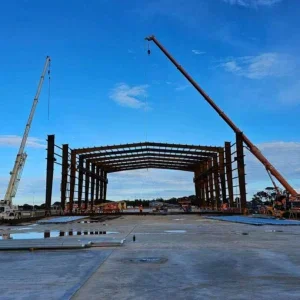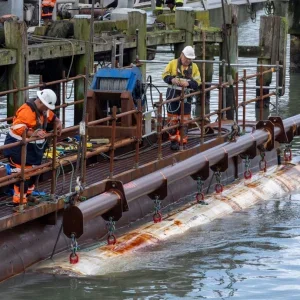The 11m diameter TBM, named Lady Eileen Hudson, has excavated 2.85km to create the main access tunnel at Lobs Hole in the Snowy Mountains in New South Wales.
Snowy Hydro acting CEO Roger Whitby said the tunnelling achievement was a significant milestone, with Snowy 2.0, a 2,000MW pumped hydro expansion of the Snowy Scheme, set to underpin the Australia’s transition to renewables.

“This is our first new major tunnel excavation in decades, since construction of the original scheme, and it gives us access to the site where we will create the enormous cavern 800m underground that will house our power station,” said Whitby. “The TBM Lady Eileen Hudson and our teams from Snowy Hydro and contractor Future Generation Joint Venture have done a great job to complete this critical tunnelling task.”
The TBM is being dismantled and will be moved to the Talbingo adit where it will be reassembled with some new components for excavation of the 6km tailrace tunnel.
While dismantling of the TBM conveyor belt gets under way in the main access tunnel, drill and blast activities are ongoing to excavate cross passages and tunnels to gain access to the power station complex, which will include a 251m-long, 52m-high machine hall cavern and 223m-long, 46m-high transformer hall cavern.
The Snowy 2.0 project will link Tantangara Reservoir (top storage) with Talbingo Reservoir (bottom storage) through 27km of tunnels and a power station with pumping capabilities. This will enable water to be released for energy generation at times of peak demand and then pumped back to the top storage when there is excess renewable energy in the system, ready to generate again.
Last week Australian media reported that TBM Florence, which is excavating the headrace tunnel at Tantangara, became stuck earlier this year after meeting variable and soft ground conditions. Snowy Hydro says the TBM is now continuing to excavate following successful reinforcement works.
“As anticipated, the ground conditions encountered by the TBMs on Snowy 2.0 have been highly variable, ranging from soft, sandy ground to extremely hard rock. The Snowy 2.0 teams have been working collaboratively to safely navigate the softer ground conditions experienced at Tantangara, including high groundwater inflows,” the organisation says in a statement on its website.
“As part of the tunnelling process we probed in advance of the TBM, identifying the soft ground ahead, and then consulted with our expert design consultants to plan for stabilisation works. TBM Florence has been specifically designed to encounter these variable ground conditions.
Consolidation grouting around the perimeter of the headrace tunnel, and internally, and installation of steel ribs to reinforce the concrete segmental lining in the soft zone, have been carried out to ensure stability and manage groundwater inflows. Additional instrumentation to monitor ground performance has also been installed.
Snowy Hydro expects variable and soft ground conditions to occur in sections of the 17km-long headrace tunnel. Further ground improvement works will be carried out where required.







